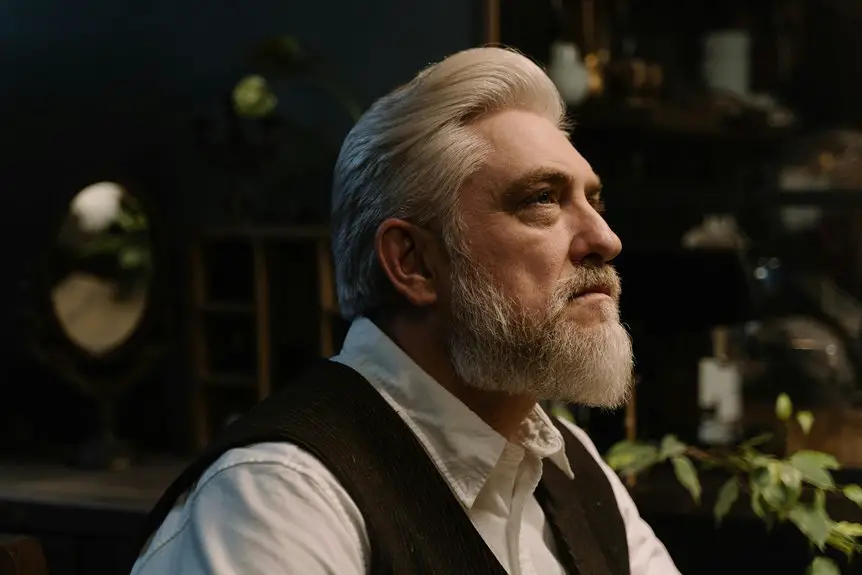Yes, corduroy was definitely popular in the 1950s. You’ll find it was valued for its texture, durability, and warmth, fitting both casual and workwear styles. You’d often see it in earthy tones on jackets, pants, and skirts, blending comfort with vintage charm. It was embraced by creative and college crowds, making it a symbol of authenticity. Keep exploring and you’ll uncover how corduroy’s classic appeal continues to influence fashion today.
Table of Contents
Key Takeaways
- Corduroy became a popular fabric in the 1950s, embraced for its unique texture and durability in fashion.
- It was widely used in casual and workwear, balancing comfort and toughness for everyday and labor-intensive clothing.
- Common 1950s corduroy garments included jackets, pants, and skirts in earthy tones like mustard, olive, and rust.
- Cultural movements like the Beat Generation and college campuses boosted corduroy’s image as a symbol of creativity and authenticity.
- Corduroy’s vintage appeal endures today due to its timeless texture, retro charm, and versatility across styles.
The Rise of Corduroy in Mid-Century Fashion
Although corduroy had existed for centuries, it wasn’t until the mid-20th century that it truly caught on as a fashion staple.
You’d notice it becoming more than just a practical fabric; designers started embracing its unique texture and durability. By the 1940s and early 1950s, corduroy appeared in various apparel, from jackets to skirts, blending comfort with a rugged yet stylish look.
You’d find it appealing because it offered versatility that suited both casual and slightly dressier outfits. As fashion shifted, corduroy’s distinctive ribbed pattern gave your wardrobe a tactile dimension uncommon in other fabrics.
This period marked corduroy’s transformation from purely functional to fashionable, paving the way for its enduring vintage charm. You’d see it as a fabric balancing tradition and modern style effortlessly.
Corduroy’s Role in 1950s Casual and Workwear
When you think about 1950s fashion, corduroy stands out as a fabric that bridged casual style and durable workwear. You’d find it in both relaxed weekend attire and sturdy, practical clothing for labor-intensive jobs.
Its ribbed texture offered toughness, making it ideal for work pants and jackets that had to withstand wear and tear. At the same time, corduroy’s soft feel and warmth made it a go-to choice for casual shirts and slacks, perfect for laid-back social settings.
Whether you were on a factory floor or enjoying a Sunday outing, corduroy gave you comfort without sacrificing durability. This versatility helped the fabric earn a unique place in 1950s wardrobes, balancing fashion with function in everyday wear.
Popular Corduroy Garments and Styles of the 50s
Corduroy jackets, pants, and skirts dominated 1950s wardrobes, offering both style and practicality. You’d often spot these garments in earthy tones like mustard, olive, and rust, reflecting the era’s natural palette.
When picking out corduroy pieces, keep an eye on these popular styles:
- Wide-wale corduroy jackets with button closures for a structured look
- High-waisted corduroy pants, flattering and functional for everyday wear
- Pleated corduroy skirts, perfect for casual and semi-formal occasions
- Matching corduroy sets combining jackets and pants or skirts for coordinated outfits
These staples allowed you to enjoy corduroy’s durability without sacrificing style, making them a go-to fabric choice throughout the decade.
Corduroy combined lasting durability with timeless style, becoming a beloved staple of 1950s fashion.
Wearing these pieces, you’d fit right into the vintage vibe of the 50s.
Cultural Influences Boosting Corduroy’s Popularity
Since the 1950s embraced a shift towards casual yet stylish clothing, various cultural movements helped boost corduroy’s popularity. You’ll find that the rise of the Beat Generation and folk music scenes favored comfortable, earthy fabrics like corduroy, reflecting a rejection of formal wear.
As you explore fashion history, you’ll notice how college campuses became hubs for corduroy jackets and pants, symbolizing intellectual rebellion and relaxed sophistication. Additionally, Hollywood’s portrayal of relatable, down-to-earth characters wearing corduroy made it a desirable fabric.
When you wear corduroy, you tap into these rich cultural influences that blended comfort with style. This fabric’s association with creativity, nonconformity, and authenticity helped cement its place as a staple in 1950s wardrobes and beyond.
How Corduroy’s Vintage Appeal Endures Today
Although fashion trends constantly change, corduroy keeps making a comeback because it blends nostalgia with modern style.
You’ll notice its timeless texture and warmth fit perfectly into today’s wardrobe, offering both comfort and unique flair.
Corduroy’s vintage appeal endures because it:
- Evokes a sense of retro charm that’s effortlessly cool
- Adapts well to various styles, from casual to chic
- Provides durability, making it a sustainable choice
- Appeals to those who appreciate classic fabrics with a contemporary twist
When you wear corduroy, you’re connecting with its rich history while staying fashion-forward.
This fabric’s ability to evolve with the times guarantees it remains a beloved staple in your closet, proving vintage can always stay relevant.
Frequently Asked Questions
How Is Corduroy Fabric Made?
Did you know corduroy’s ridged texture comes from weaving extra sets of yarn into the base fabric? You’ll see these raised “wales” formed by cutting the loops, giving corduroy its unique, soft feel.
What Are Different Types of Corduroy Wale Counts?
You’ll find corduroy wale counts vary from pinwale, with very fine ribs, to wide wale, which has thick, prominent ribs. Mid-wale sits between, giving you options depending on texture and style you want.
Is Corduroy Considered Environmentally Friendly?
Imagine wrapping yourself in nature’s gentle hug—corduroy can be eco-friendly if made from organic cotton or recycled fibers. You’ll want to check labels carefully since production methods vary widely in environmental impact.
How Should You Care for Corduroy Clothing?
You should wash corduroy inside out in cold water, use a gentle cycle, and avoid bleach. Hang or lay flat to dry, then iron on low heat if needed to keep its texture soft and vibrant.
Can Corduroy Be Used in Home Decor?
You’ll find corduroy brings a cozy charm to your space. It’s perfect for cushions, upholstery, or curtains, adding texture and warmth without overwhelming your decor. Just keep it clean and soft to maintain its inviting feel.
- Does Chiffon Fabric Stink - July 15, 2025
- Does Chiffon Fabric Affect the Economy - July 15, 2025
- Does Cotton Fabric Have a Nap - July 15, 2025







